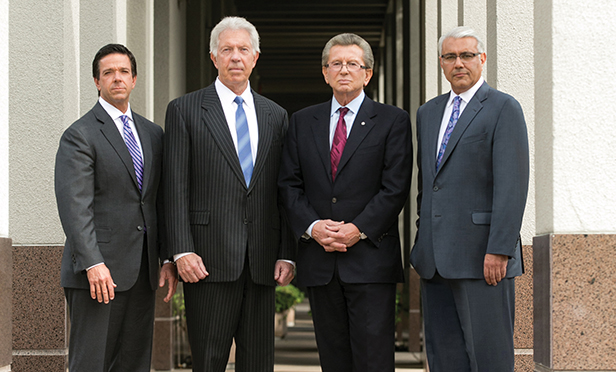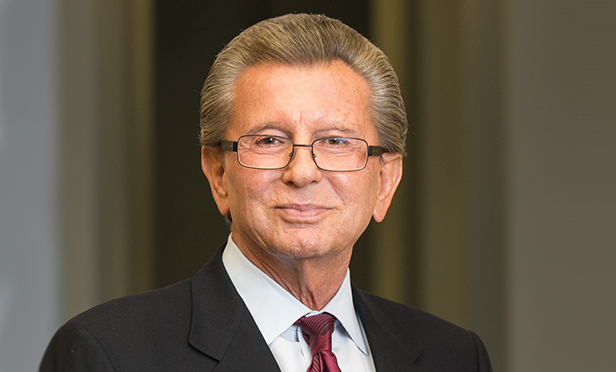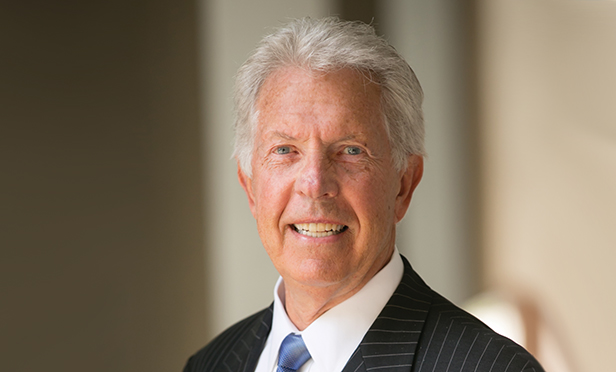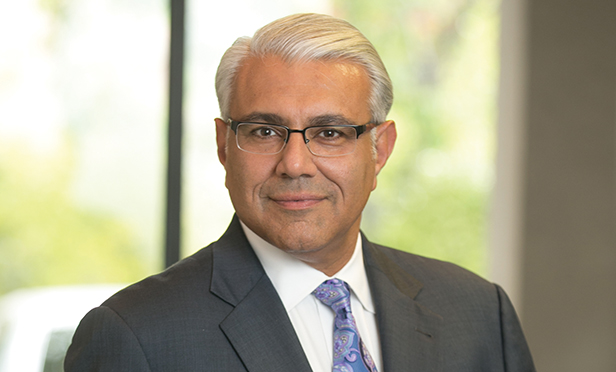 From left: Mitchell LaBar, William Millichap, George Marcus and Hessam Nadji (PHOTOS by James Fidelibus)
From left: Mitchell LaBar, William Millichap, George Marcus and Hessam Nadji (PHOTOS by James Fidelibus)
This is an HTML version of an article that ran in Real Estate Forum. To see the story in its original format, click here.
There isn’t much on the commercial real estate landscape of 1971 that has come down to us essentially intact 45 years later. Companies as well as individuals have come and gone, countless properties have changed hands—in many cases, several times over—and the entire modus operandi of doing deals has been transformed. Yet one organization that got its start in the very different world of 1971 is marking its 45th anniversary with the same basic premise that led founders and co-chairmen George Marcus and William Millichap to set up shop: an investment sales platform that matches properties with pre-qualified investors, and a focus on measuring success with the yardstick of client satisfaction.
“I first started in this business as a sales agent with George,” Millichap tells Real Estate Forum. “I would ask clients for an exclusive, and they were dumbfounded that I asked. Brokerages didn’t represent the buyer and they didn’t represent the seller—they represented the deal.”
Marcus saw a different path, believing that “a brokerage that was committed to the client and a client that was committed to the brokerage through an exclusive marketing agreement would produce better results, so that’s how we set up the business,” Millichap continues. “It was the first business model dedicated to investment real estate brokerage as a specialized focus. To make it work, we had to create a system for exposing each property to the largest pool of qualified buyers, which spawned the need for size and scale and the need for information sharing and collaboration throughout the sales force.”
The model on which Marcus & Millichap’s founders based their organization is still in place today. Yet the company hasn’t exactly stuck to doing business at the same old stand since 1971. For one thing, there’s the scale it has achieved over the years, now encompassing 79 offices across the US and Canada with more than 1,600 sales and financing professionals. From those offices and brokerage professionals came 8,700 transactions in 2015, valued at approximately $37.8 billion, including $4.9 billion in debt and equity structures through Marcus & Millichap Capital Corp. (MMCC).
And although Marcus & Millichap successfully branched out into the institutional segment with the launch of its Institutional Property Advisors platform in 2010, it is the industry’s leading firm in the $1-million to $10-million private client segment. According to company estimates, this category comprised 83% of all commercial property sales in the market nationally over the last year. Marcus & Millichap reported first-quarter growth of 10.8% in private-client transactions over the same period in 2015, demonstrating that there’s still plenty of opportunity to increase market share among this investor class.
The ready availability of Q1 numbers points to another aspect of M&M’s evolution: it has been a public company since November 2013, when it began trading on the New York Stock Exchange under the MMI symbol. Most recently, the company has gotten new leadership with the promotion of senior executive vice president Hessam Nadji to president and CEO, and the naming of Mitchell LaBar, also a company veteran, as COO. Both appointments took effect earlier this spring.
 “Success by our definition has always been measured by optimizing results for the client, which requires collaboration and information sharing.”—George Marcus, Co-Chairman
“Success by our definition has always been measured by optimizing results for the client, which requires collaboration and information sharing.”—George Marcus, Co-Chairman
“Our primary focus has been the private, entrepreneurial client,” Nadji tells Forum. That business model is a point of differentiation in and of itself, he adds, “because there’s really no other platform of our size and scale and with the consistency in the way we do business across the country. This has put us in a unique place within the industry, including our ability to bridge the private capital and institutional markets, tie in research, advisory services and financing.”
Accordingly, Marcus tells Forum, “Being public is actually more important for discipline purposes. The public market forces you to crystalize your strategy and to make decisions without undue hesitation.”
Focus and discipline are not new to M&M as it has demonstrated through its financial success and carving out a niche in the industry. Nadji adds, “George and Bill instilled disciplined management of the company, even when it was much smaller and private. We were lucky to have had that discipline over the years; it prepared us for becoming a public company.”
The founding of M&M marked “the beginning of what later would be called ‘category killers,’ to describe a highly specialized segment of industries,” says Marcus. “We decided to specialize in investment real estate brokerage and concentrated our efforts on perfecting it. As with any new concept, it took a while to catch on and get buy-in from investors and new agents. In fact, training agents in this new method of marketing investment real estate became critical from the start since they had to understand the nuances of our model, such as providing a higher level of information, research-based underwriting and other concepts that were not common practice. We became a training-based organization from the start.”
Historically, says Marcus, “Many brokerage firms defined success by simply executing a sale. Success, by our definition, has always been measured by optimizing results for the client, which requires collaboration and information sharing. Many brokerages have had legacy issues that make a collaborative investment brokerage model with critical mass difficult to implement. Since we started the firm with these founding principles, we have been able to evolve and grow it.”
A single agent marketing an asset to a target client base faces “a huge competitive disadvantage compared to our company. We may have 30 active investment brokers in an office with 10 to 20 clients each that could be suitable for a particular investment opportunity, and it is mandatory that the listing is shared in our system,” Marcus adds. “Multiply this by 79 offices and over 1,600 specialized, highly trained investment and financing professionals, which is the scale to which we have grown, and the impact on client service and value becomes clear.”
Millichap offers insights into the continuing relevance of M&M’s information sharing/collaboration approach. “Two of the core concepts of client representation are that the property being marketed has been researched and that the offering is deliverable,” he says. “With this foundation the next challenge is to effectively expose the property to motivated and qualified buyers. We mandate that each property that is exposed to the market is done so in a manner that is consistent with the client’s objectives and directives.”
Accordingly, he continues, “Our clients know that we have the ability to expose the property throughout our entire system and that they have a company, not just an individual broker, representing their interests. Without information sharing and collaboration, the marketing process goes back to the inefficiencies that were present in 1970.”
 “Through technology we monitor a huge number of data points, which when combined with ‘human judgment’ and trend analysis can create real value for our clients.”—William Millichap, Co-Chairman
“Through technology we monitor a huge number of data points, which when combined with ‘human judgment’ and trend analysis can create real value for our clients.”—William Millichap, Co-Chairman
With that foundation of sharing and collaboration in place, LaBar tells Forum, “We’ve been very effective at helping motivated people with the necessary work ethic become incredibly successful in our business.” He points out that a number of elements contribute to this success. “If you have a manager who has been an investment broker, whose entire life depends on growing an office in a collaborative way for the long term, who does not compete with you for commissions and spends a lot of time training you in a very structured way, your odds of success go way up as an investment sales or financing professional with our firm.
“With the manager as someone to guide you, test you and help you along the way, the various modules of our training programs, which have been developed over four decades and keep getting refined, make a big difference as well,” LaBar continues. In short, it comes down to experience trickling down. “There is a technical real estate component, a sales component and a large piece on how to run your practice taught by people who have done it.”
Naturally, some of the company’s new agents include seasoned brokers “and for them, it’s more of an enculturation and training on leveraging the M&M platform to their advantage and the advantage of their clients,” LaBar says. Since many have never experienced “our tools, research, specialty divisions and so on,” there is a learning curve.
That learning curve doesn’t start on the broker’s first day of work. Well before bringing aboard anyone— regardless of their previous experience—the firm gives them a detailed overview of how its model works and how it’s different, explains LaBar, adding, “The entire business model is built on collaboration and information sharing.” On a day-to-day basis, this could include “referring business to one another to help a client, co-listing among agents when one has the client relationship and the other may have a better product or market knowledge, or integration between our financing experts and investment sales,” among other scenarios.
“Marcus & Millichap is an entire system of really effective, well-trained and equipped individuals that work together in a web of collaboration to execute for the client locally, regionally and nationally,” LaBar says. All of which, he adds, is enabled by state-of-the-art technology. “Collaboration is not just encouraged; it’s the culture and the way the whole business model works.”
Technology became a core focus early on in the company’s evolution, given the need for information sharing. “We had a wide area network connecting all of our offices in 1978 long before competitors embraced computer technology,” Millichap relates. “In 1978, each office and each of our brokers knew what properties were being marketed by the company. This early information exchange increased our ability to disseminate information rapidly and to ‘make a market’ for income property. It’s relevant today because we constantly find new ways to bring more efficiency to our brokers and clients.” To cite an example, he says, internal information management enables M&M’s professionals to identify trends and advise clients on market changes before the data is generally available and therefore less valuable.
As impactful as information technology has been on the process, “it is still limited by the fact that real estate assets are not owned by computers,” says Millichap. “The ability of an effective broker to respond to client concerns and act in a consulting role allows them to create value by advising them well beyond the online regurgitation of static data. Properties that are primarily ‘Internet’ marketed are usually over-shopped and may not be benefiting from the added value an effective broker can bring to electronically disseminated information. Through technology we monitor a huge number of data points, which when combined with ‘human judgment’ and trend analysis can create real value for our clients.”
When the time came to choose a successor to CEO John Kerin, who retired in March after 35 years with M&M, Nadji ranked as the most qualified candidate. “We always have evolution in businesses and have to continually develop leadership talent,” Marcus says. “It’s really simple: Hessam probably has the firm’s best record of hiring executives. He is one of the most articulate people in the industry, let alone the company. He has strategic thinking capability and loves what he does. This combination, along with his forthright and honest dealings with people, makes him the natural choice to lead the firm. Hessam literally has gained the respect of everyone in the organization.”
 “The way we integrated services, technology and research in the past is evolving into a whole new way of thinking about productivity, yield maximization and service delivery.”—Hessam Nadji, Chief Executive Officer
“The way we integrated services, technology and research in the past is evolving into a whole new way of thinking about productivity, yield maximization and service delivery.”—Hessam Nadji, Chief Executive Officer
For his part, Nadji sees the role of CEO as an opportunity to apply everything he has learned in his 20 years with M&M. “I have been fortunate to have spent the vast majority of my time with the company working directly with our agents and clients,” he says. “At the beginning, my job was to help transition the firm toward more of an advisory and consultative model by implementing market research, not just as a separate, standalone producer of reports and analyses but also through research that enriches the agent-client dialogue, by providing reasons to talk, reasons to meet and, essentially, to have a relationship.”
His role then evolved into developing the long-term strategy for the company and helping to prepare and execute the IPO. Nadji also ran M&M’s specialty division sales units, tasked with growing various lines, “which again required working directly with many of our most senior brokers,” says Nadji. “Having an understanding of our brokers’ and clients’ needs through my various roles has been the most valuable preparation to lead the company.”
Less than two weeks after Nadji was selected to replace Kerin, he named LaBar the company’s new chief operating officer. LaBar’s tenure with M&M dates back to 1984, when he joined as an agent in the firm’s Newport Beach, CA office. Before leaving in 2008 to become a private investor, he was a regional and divisional manager, and opened the company’s first offices in the Northeast. “So there is really no portion of the continuum of what we do that I haven’t personally been involved in,” he comments.
His return to the M&M fold in 2015 was initially in a consulting capacity. After seven years on his own, LaBar brought “a fresh view of the company from the outside,” says Nadji. “Mitch is the absolute ideal COO, because he has this 25-year treasure chest of experiences—in opening and running offices as well as in hiring and managing managers and top agents,” he adds.
According to Marcus, “Mitch exemplifies the culture and attitude that make our company unique and we are very fortunate to have him.” He sums up, “Together, Hessam and Mitch will comprise a great leadership team.”
Beyond the C-suite, Nadji points out, “You have to remember that we have a deep bench of senior executives and very capable regional managers that provide incredible depth to our management team. Our group managers, senior specialty executives and senior regional managers have been with the company an average of 17 years. To supplement this, we have brought on segment executives in capital markets, office/industrial, retail, hospitality and IPA with extensive experience to lead these units. The core focus for our entire management team is to provide the absolute best support to our agents and assure that clients’ needs are being met and it’s proven to be very effective.”
As M&M’s key players look toward the future, “We are very proud to be celebrating our 45th year in the business,” says Nadji. “It’s exciting to realize that despite the company’s tremendous accomplishments, innovations and brand, we have significant opportunities to grow.”
Marcus elaborates on this forward-looking vision. “We look at the nature of our clients and our brokers in the 16 different property specialties that we service and realize that there is still room for growth and improve services in each specialty,” he says. “This is true whether we are dealing with seniors housing, hotels and self-storage, or our primary core private client business in the $1-million to $10-million apartment, retail, office and industrial segments. Our financing business has its own nuances and interesting opportunities. Investors and brokers in each specialty have different needs nationally and internationally and these are changing all the time.”
The company’s growth plan has three major components, explains Nadji. “First, we are growing share in the $1-million to $10-million private client segment. This is the largest market segment by far and we have the leading market share and brand within it. It’s a dynamic investor base with high net worth individuals, partnerships and private fund managers that deal with death, divorce, partnership formations and break-ups, wealth transfer and other life factors that impact their investments. Through our 45-year history, we have gotten very close to them and understand them very well. We believe there is more room for growth, even in apartments and retail, which are our leading market segments.”
 “Collaboration is not just encouraged; it’s the culture and the way the whole business model works.”—Mitchell LaBar, Chief Operating Officer
“Collaboration is not just encouraged; it’s the culture and the way the whole business model works.”—Mitchell LaBar, Chief Operating Officer
Secondly, M&M is growing its specialty divisions such as hospitality, seniors housing, self-storage, student housing and other niches that offer plenty of room for growth. “This further builds on our strength in helping investors move capital across property types and geographic boundaries,” says Nadji. Part of the specialty expansion includes the IPA platform, dedicated to larger private and institutional investors.
“We have built a very competitive institutional brokerage platform for this segment to support and enable our maturing brokers to pursue larger clients as their career evolves,” Nadji says. “We are also uniquely positioned to bring private capital to institutional assets because of our deep penetration among private investors who have amassed quite a bit of equity over the years. Many of our private clients are consolidating portfolios into fewer, but larger, institutional-quality assets and we are there to help them.”
Last but not least, the company is “aggressively growing” the MMCC platform. “We now have 100 loan originators, which can expand to be a much larger group through organic growth and possibly some acquisitions,” says Nadji. “Besides the revenue growth opportunity, MMCC has proved to be a major value add in the way our experts can help enhance the long-term client relationship through refinancing,” or simply in helping the investment sales team provide a wider range of knowledge and services.
Supporting the growth initiatives is what Nadji calls “a major emphasis on further integration of investment sales with advisory services and capital markets expertise. Once again technology is at the center of it. The way we integrated services, technology and research in the past is evolving into a whole new way of thinking about productivity, yield maximization and service delivery. “Our growth plan is really about doing a better job for our clients,” Nadji concludes. “This means market penetration, earning more repeat business and having a tenured sales force with successful long-term careers with the company.”
















 Copyright © 2024 ALM Global, LLC. All Rights Reserved.
Copyright © 2024 ALM Global, LLC. All Rights Reserved.